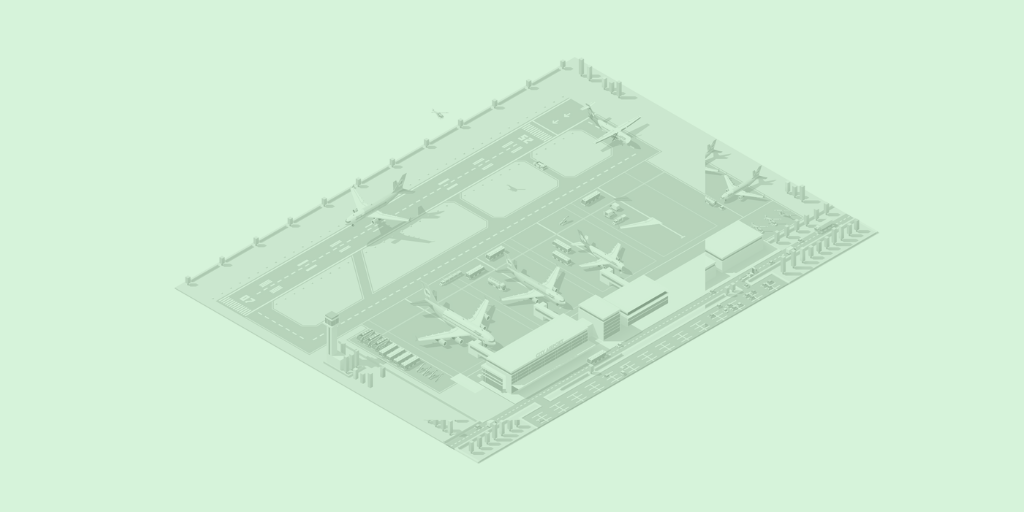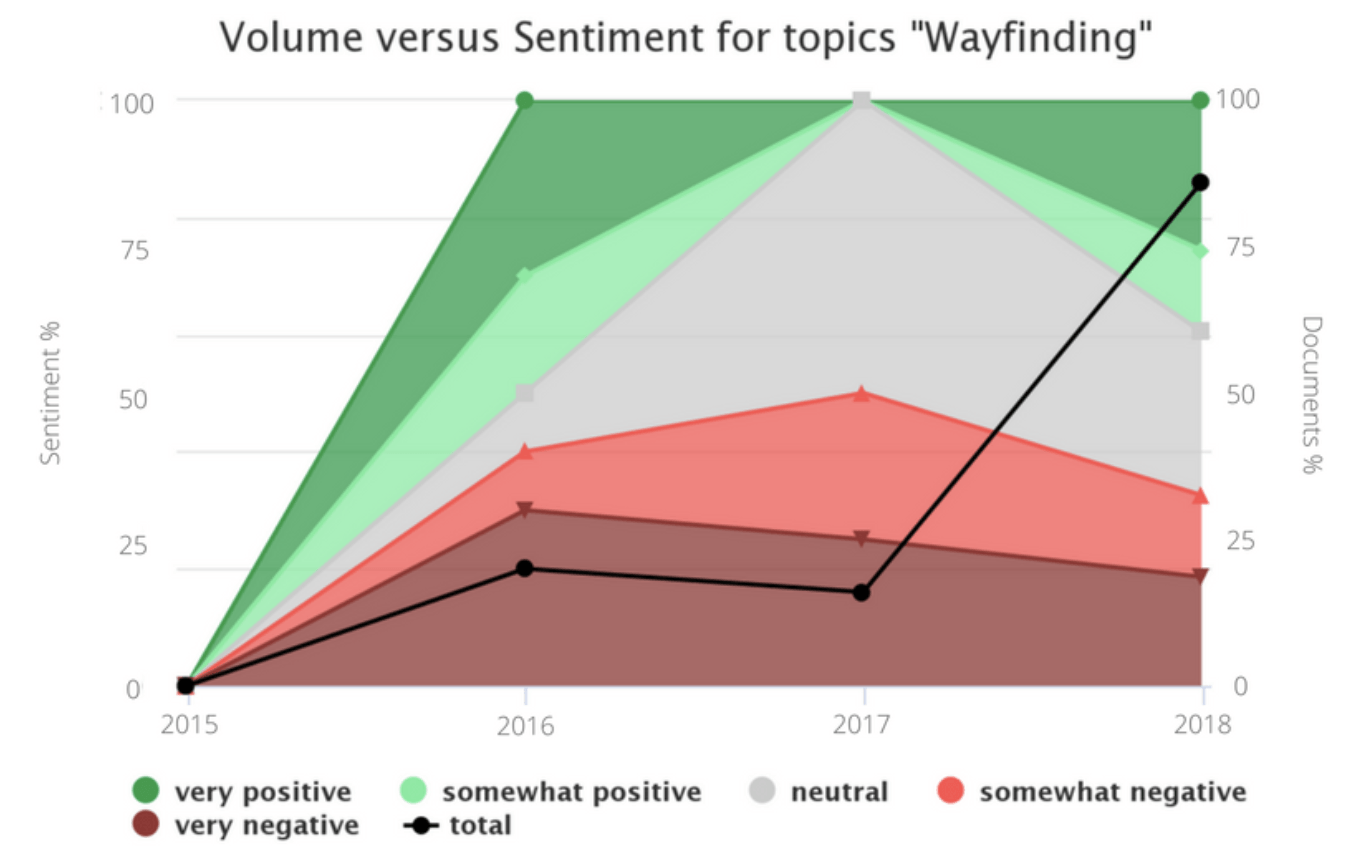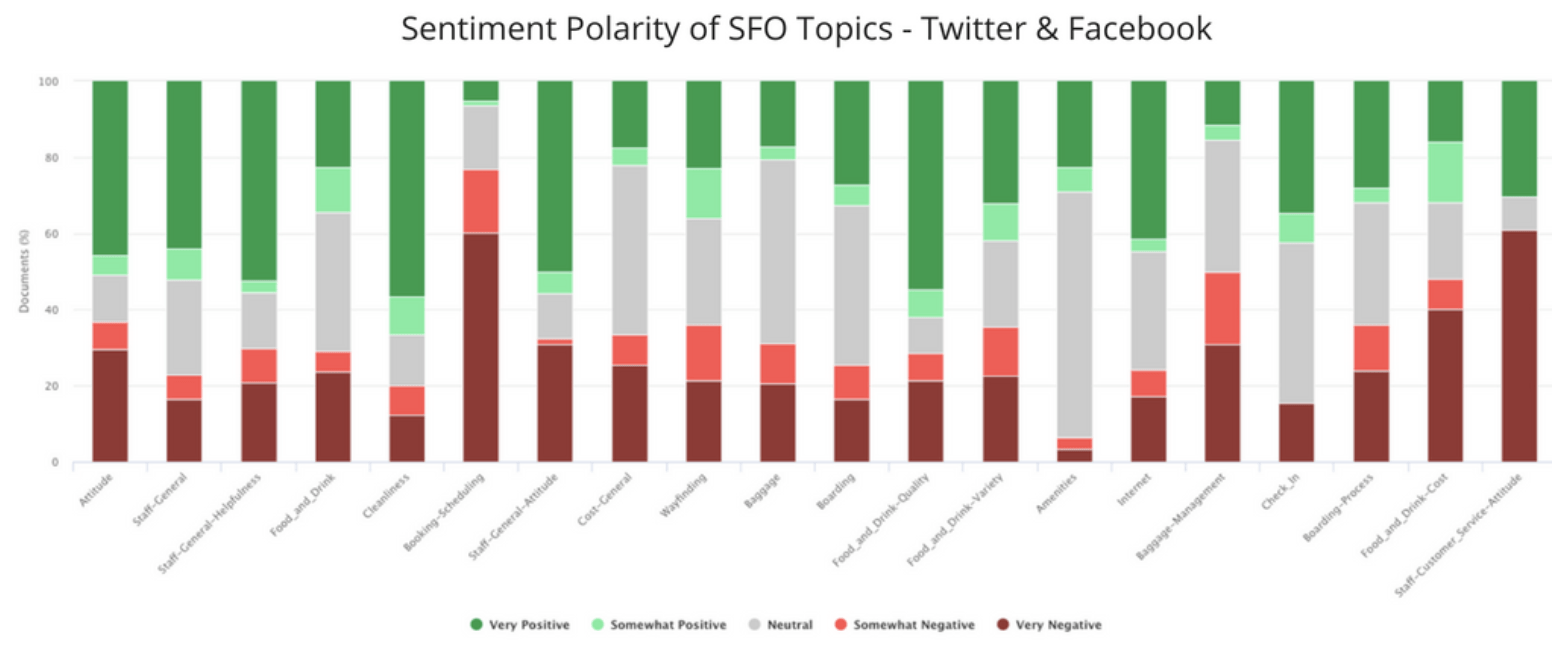Airport Analytics: SFO and Building a Better Delay
San Francisco International Airport is the gateway to the world's tech capital. In this installment of our airport review analytics series, we see how SFO effectively listens to its customers to guide billion dollar terminal renovations and make daily improvements.
In this series, we’ve been using text analytics to analyze the social media data around America’s busiest airports. In this installment, we broaden the scope to include Tweets as well as Facebook reviews. To begin, San Francisco International Airport is not having the greatest year. Over a six-month period, SFO had three near-miss aviation accidents, any one of which could have been “the worst disasters in aviation history” according to a Business Insider report. An editorial from the local Mercury News calling for “action” from the federal government reveals that over a 14-month timespan there were two additional near-misses. SFO has been called the “worst” airport to travel through during the holidays by the New York Daily News, and a 2012 study supposedly found that SFO was the “worst” airport in the country when it comes to delayed or cancelled flights.
Nonetheless, upon closer inspection of the airport’s social media, it’s easy to see that stopping short at occasional bad press and travel column listicles gives only a fraction of SFO’s story; to wit, San Francisco excels where many other airports in this series fall down. As an example, take wayfinding, the architectural study of how people orient themselves in physical space and navigate from place to place. Airports are complex buildings to design. In premise, they must connect large, mixed use spaces through navigational cues intuitive enough to be grasped by cabin crew and children alike. Frequently however, the design falls short of effectively communicating with the subconscious. SFO is no exception, said one disgruntled traveler on Twitter in 2017: “Why aren’t there helpful signs here @flysfo?”
Social listening for airports
San Francisco International Airport actively listened to this feedback, recently pivoting a negative narrative into a positive one. “Yes, we do get comments from passengers [who find themselves lost]” said Judi Mosqueda, SFO Director of Project Management. In response, the airport allocated $7.3 million to remedy the problem throughout the 2.5 million-square-foot space. That was in January, and text analytics already demonstrates a positive customer feedback. One frequent flyer to the United States stopped by the SFO Facebook page to shower praise on the new wayfinding experience: “I find SFO to be one of the easiest airports in the USA to navigate,” they say. “Kudos to SFO for consistently providing a super travel experience!”

Building a better delay at SFO
San Francisco International, like all airports, can spark the ire of its customers when acts of nature foil schedules — perhaps more frequently than most, compliments to its fog, Karl. However, the airport aims to mitigate the stress of delays by investing in lounges, a yoga room, complimentary high speed broadband, museum installations, therapy animals, and more — all of which is represented in the topic sentiment present in the social data.

What is more, recent renovations to Terminals 2 and 3 set a strong standard for other American airports to follow. The social media data set is replete with praise for the new terminals, which boast sophisticated art exhibits, stylish seating areas, strong food vendor offerings, and evocative architectural features, with one reviewer describing the airport as “architecturally stunning.”
“Terminal 2 is probably the nicest domestic terminal in the entire country. Spacious, modern, clean and plenty of places to sit + free wifi!” says one reviewer. Another echoes this sentiment on Twitter, pointing out simply that “Terminal 2 is a class act!” Recently, a customer doubled down on this sentiment, urging SFO to begin similar renovations on Terminal 1: “Terminal 2 in SFO… best terminal by far in the USA. Can’t wait for the renovations in Terminal 1!”
While considering the design for Terminal 1’s renovation, which is estimated to be a $2.4 billion project, SFO’s stakeholders and the design firms they work with ought to dig even deeper into the text. Many of SFO’s review specifically target the airport’s facilities. A frequent target is the connector passageway between Terminals 2 and 3, or rather the lack of it. In 2009, SFO developed a connector passageway between the domestic Terminal 3 to the International Terminal. However, there is no way to navigate between the Terminals 1, 2, and 3 without exiting security. Says one aggravated guest, “I had to move from terminal 3 to terminal 1 and I had to get out one terminal and to get into the other one and I had to go through the already tedious, painful and unfriendly/brainless/rude TSA security checkpoint. Why don’t they have a way to move through terminals without passing security.” Being able to move freely between terminals, especially during a stressful delay or layover, makes a monumental difference in a customer’s experience at an airport.
Beating the competition by winning travelers
Text analytics helps airport stakeholders and travelers alike cut through the noise of editorialization by identifying the signal present within actual user data. With this technology, airports like San Francisco can better respond reactively — like in the case of wayfinding — while developing other proactive structural strategies to grow the customer base. What is more, SFO operates in a busy travel corridor where it competes with two other nearby airports, Oakland International and San Jose International, all the while protecting its market share from the behemoth in the south: LAX. This level of competition is not uncommon in the United States. As such, major airport brands need to get an edge where they can.
More from this series: airport review analytics
Series introduction: Analyzing Airport Reviews using Natural Language Processing
- Atlanta International has a big problem with “wayfinding”
- Charlotte Douglas can profit big by listening to their customers
- Chicago O’Hare needs to learn about viral reputation management
- Dallas/Fort Worth has a dirty secret
- Denver International may be a secret haven for the Illuminati
- New York’s JFK has to plan for the future
- Las Vegas McCarran doesn’t shy away from your vices
- San Francisco can teach us about listening to customers
- Seattle-Tacoma has a vocal customer named Jerry
- Los Angeles needs to master the “final mile”
Series summary: The Definitive Data-Driven Airport Ranking List

